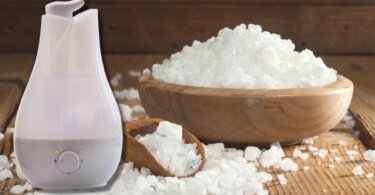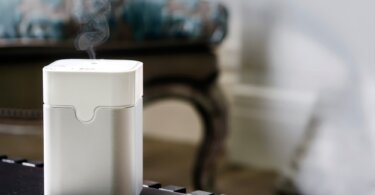Is your humidifier causing trouble? Are you scratching your head, wondering why your humidifier isn’t working? Maybe no mist is coming out, or your humidifier is leaking water?
All this has probably made you wonder if you should just get a new humidifier.
We’ll stop you right there. All hope is not lost. With a little help from us, you might be able to fix your humidifier without much trouble.
If you live in an area with a cold climate, you might know how crucial it is to a humidifier. The dry air of colder climates isn’t the best for your skin and respiratory system. Therefore, it’s better to learn how to fix a humidifier if it’s causing you trouble.

Know the Type of Humidifier You Have
Firstly, before attempting to fix the problem, you need to figure out the type of humidifier you have. This can help you understand and fix the issue more efficiently.
So, let’s look at some off the main types of humidifiers:
- Warm mist humidifiers produce warm, visible mist. They’are great for getting rid of the dryness from the air, while also providing warmth.
- Cool mist humidifiers produce cool invisible mist. They usually have filters to trap impurities and debris and are quite easy to clean.
- Ultrasonic humidifiers create water droplets using a diaphragm that vibrates at an ultrasonic frequency. They produce a cool fog and tend to be pretty quiet.
- Evaporative humidifiers, also known as wick humidifiers, take in the air using an internal fan. This air then goes through a wick filter, which is moist with water. These humidifiers are cost-efficient.
Once you’ve figured out which type of humidifier you have, it’s now time to tackle the issue at hand.
Recommend: How to Make a Homemade Humidifier
Why is My Humidifier Not Producing Mist?
Don’t lose hope if your humidifier is not steaming. Like all appliances, sometimes humidifiers also stop functioning correctly. One common issue is that they stop blowing mist.
The first thing to do is consult the manufacturer’s manual that came with your humidifier, as certain repairs may impact your warranty.
No matter the cause of the problem, make sure to unplug the unit from the power source before you start inspecting it. As it is hazardous to mix water and electricity.
Also, be sure to completely drain all the water from the reservoir to avoid unnecessary complications.
Let’s look at some possible reasons why your humidifier is not blowing mist and how to fix them.
Low or No Power
This one is pretty obvious; if there is no or low power, your unit will not function properly. Inspect to see if the motor is active and if the digital monitor on the unit is on. If both aren’t functioning, there may be a power issue.
If your unit is plugged into a power source and still isn’t working, there might be a problem with the source. We suggest unplugging it and testing another appliance (such as a lamp or fan).
Read also: How Many Watts Does a Box Fan Use
If the other appliance works without much trouble, take your humidifier to a repair shop. If your product warranty is still valid, it’s better to make use of it and directly send your unit to the manufacturer for repair.
Lack of Water
Another possible reason why no mist is coming out of your humidifier might be the lack of water. Humidifiers fill the air with moisture by evaporating water from its reservoir. So, low levels of water may prevent your device from functioning properly.
This solution to this is quite simple. All you need to do is to inspect and refill the tank of your humidifier. Depending on the dryness and temperature in your area, you may need to fill your reservoir several times.
Blockage Caused by Debris
The accumulation of mineral sediments can also prevent your humidifier from producing steam. Generally, tap water has minerals that can clog the filter or the heating element of your appliance.
Must read: The Best Water for Your Humidifier
Removing Debris from Warm Mist Humidifier
If you have a warm mist humidifier, then it is likely that there is mineral blocking the heating elements.
These parts are in charge of converting water into steam. As tap water moves to the heating elements, it evaporates, however, the minerals and impurities remain, slowly building up over time.
The crusty dark coat of minerals creates a layer of insulation and prevents the water from turning into steam. The solution to this problem is to simply chip off the layer of minerals from the part.
Most units come with a special tool to help you open the cap of your unit. Using your tool, carefully open the cap. Once you see the heating elements, chip the mineral deposits off. Do not use sharp objects, and be careful not to damage the heating elements.
Alternatively, if you’re having a difficult time cleaning the heating elements while still attached to the unit, you can also remove them. We suggest referring to the user manual of your humidifier to understand the whole process.
Once the heating elements are free of debris, you can close the cap, fill the reservoir, and plug your unit again.
Removing Debris from Cool Mist Humidifier
For cool mist humidifiers, mineral deposit usually accumulates on the filter. However, most cool mist humidifiers do not have filters.
If your unit has a filter, you can simply fix it by cleaning or changing the filter. Again, we recommend going over the user manual for guidance regarding the proper process.
Read also: Best Humidifiers That Use a Water Bottle
Why is My Humidifier Leaking Water?
If your humidifier is leaking water, we have just the troubleshooting and repair tips you need to get rid of the issue.
Usually, for portable models, water might leak if the reservoir tank isn’t placed properly. So, before starting your unit, ensure the tank is in its place entirely.
On the other hand, for whole-house units, several reasons might lead to water seepage.
Before calling a professional, try troubleshooting by following through with some of these tips.
Water Pressure
You can start by checking the water pressure in your plumbing system. Usually, whole-house humidifiers use the same water source as the rest of your house. You may find a small pipe connecting the main water supply to the humidifier.
The high water pressure might cause an overflow of water, forcing the cutoff valves into your humidifier. Generally, the pressure of your pipelines should be less than 125 psi.
Unless you’re an expert at plumbing, it’s best to call for a technician.
Drainage Pipe
Besides the connection to the main water supply, whole-house humidifiers also have a drainage tube, which allows excess water to flow out.
If there is any blockage or if the downhill flow is unsteady, water leakage is possible.
Check to see if anything is blocking the hose. You can remove the pipe from the humidifier and run water through it to remove any blockage. When attaching it back onto the unit, ensure there aren’t any twists.
Evaporator Pad
Like portable humidifiers, any obstruction on the filter of a whole house humidifier can also cause water leakage. Whole-house humidifiers produce steam when air is blown through a filter called the evaporator pad.
As with portable humidifiers, the evaporator pad can get clogged over time with minerals and other dirt. In most cases, you can simply clean the evaporator pad, and your unit will be as good as new. For a better understanding of the cleaning process, refer to the instruction manual that came with your unit.
Read also: Pros and Cons of Whole House Humidifiers
Solenoid Valve
The word ‘solenoid’ may sound technical, but trust us, it’s nothing too complicated.
The solenoid valve refers to the electric valve that manages water flow from the main supply to your unit. It monitors the water levels in the reservoir, allowing more inflow when the water level is down. Once the water has filled up to the required level, the valve closes.
However, at times, dirt and debris can also accumulate on the valve, preventing it from closing completely. This may eventually lead to water leakage.
You can fix this issue by following these steps:
- Start by cutting off the humidifier’s water supply and by unplugging the unit from the power source.
- Remove the valve from the unit; make sure you understand how it is installed before you remove it.
- You can use water or air pressure to get rid of the debris from the valve.
- Once the dirt and debris are gone, you install the valve back into the unit.
Related article: My Humidifier Gets Everything Wet on the Floor
What Are Common Problems With Humidifiers?
Minerals or dust and dirt can block the filter and cause the humidifier to malfunction. You need to keep the evaporator pad and filter clean. Another risk is that the humidifier might end up creating too much humidity in the room, which can trigger allergies or help dust mites proliferate.
How Do I Know If My Humidifier Is Broken?
Check whether the water is leaking. If water is leaking from its hose, it is a sure sign that there is an issue with the humidifier.
Moreover, if the humidifier remains broken for some time, the room will become dry. Dry air can cause itching in the eyes and head. Some people might even get nosebleeds.
How Do I Reset My Humidifier?
Here are the steps you need to follow for most cases:
- Unplug the humidifier from the power source.
- Press the restore button gently and hold it.
- Now, connect the humidifier to the power source while holding the restore button.
- Hold the button almost for 10 seconds.
- An orange light will blink continuously during this time.
- Release the button when the blinking light turns green.
Conclusion
Whether no mist is coming out of your humidifier or leaking water, our tips will help you resolve the issue without any trouble.
Remember that a little care and maintenance can add to the efficiency and longevity of your humidifier.




